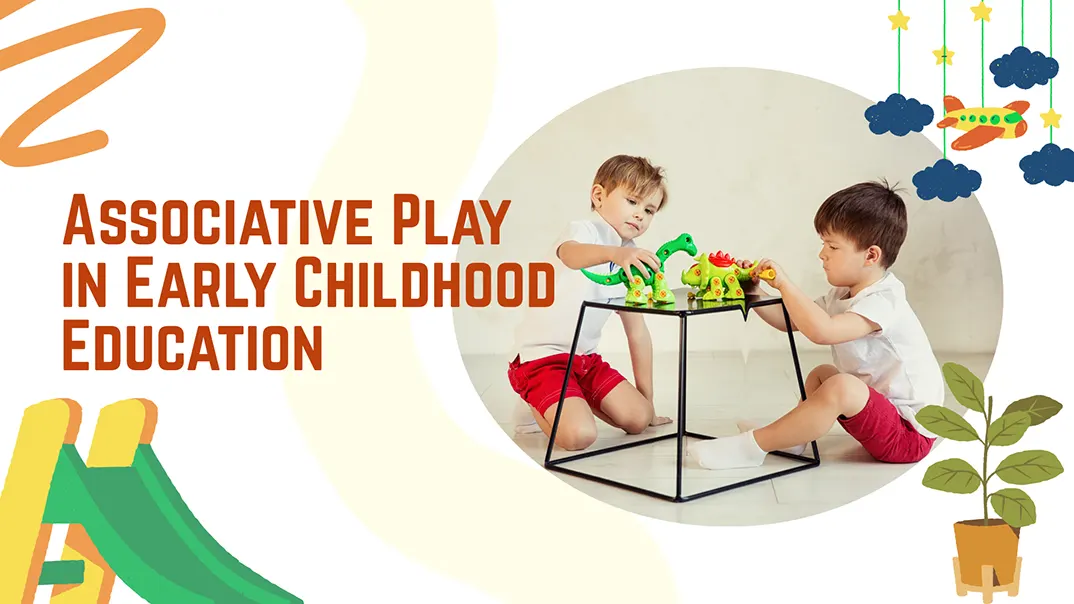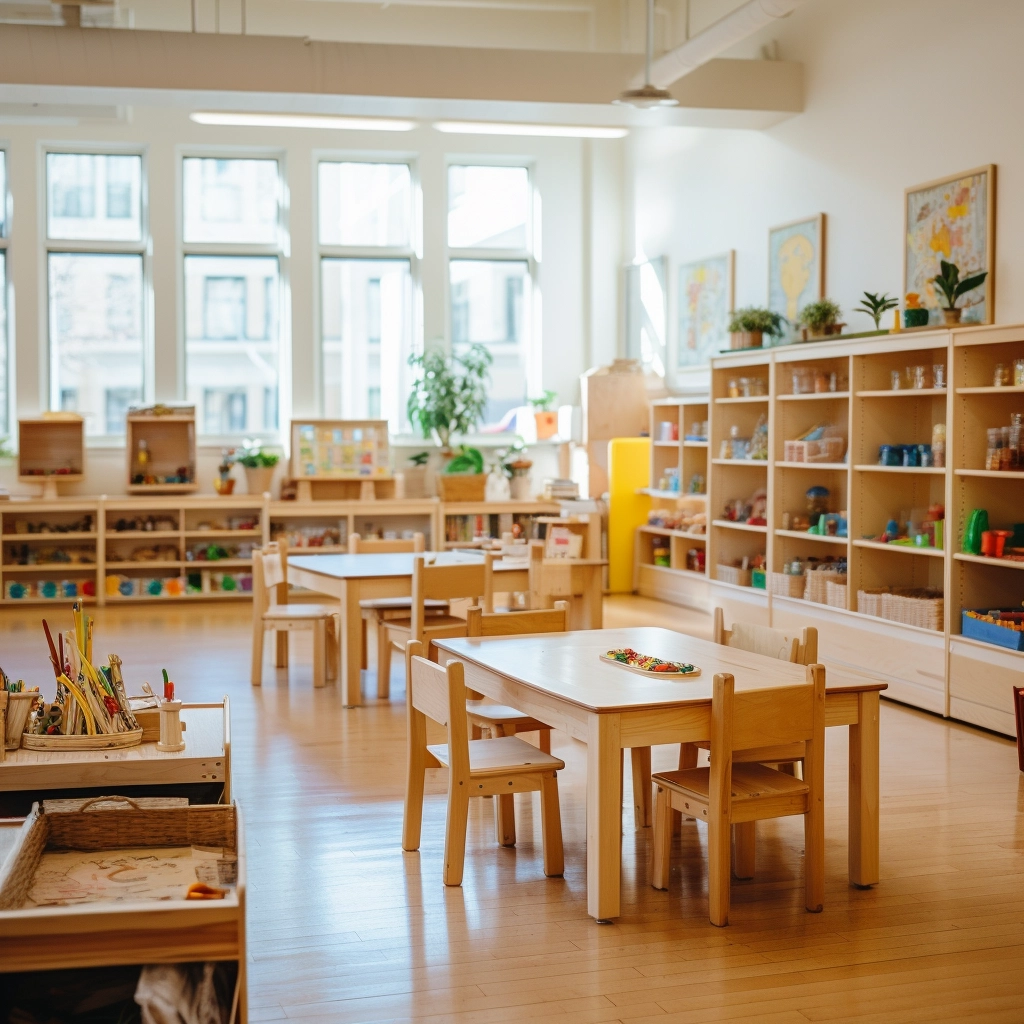Associative play helps children develop social skills through interaction that feels natural and unforced. Imagine two preschoolers painting next to each other while chatting about their favorite colors. They are not working on the same painting, but they are learning how to talk, share, and respond to each other. These are the early seeds of connection.
In early childhood education, understanding the stages of play is essential for designing effective classroom environments. Recognizing when a child enters the associative stage helps teachers and caregivers offer the right guidance at the right time.
What Is Associative Play?
Associative play is a developmental stage in early childhood where children begin to interact with one another during play without following a shared plan or specific rules. In associative play, children may use similar toys, engage in the same type of activity, or play in the same space, but each child follows their own storyline or idea. However, what sets this stage apart is the increasing verbal interaction, toy sharing, and visible interest in one another’s play.
This stage typically emerges between the ages of three and five, representing a meaningful shift from solitary activity to social exploration. Children begin to show interest in their peers’ presence and behavior, initiating conversations or offering toys without needing to collaborate on a single outcome. It reflects an early understanding of relationships, empathy, and the desire for connection.
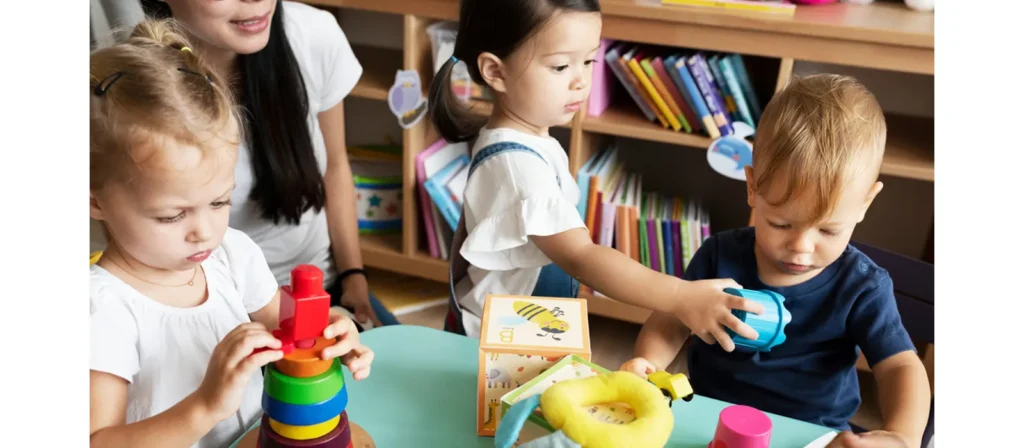
Understanding Associative Play Through Parten’s Stages of Play
The concept of associative play was first introduced by sociologist Mildred Parten in her influential theory on the stages of play. According to Parten, children move through six distinct stages of social play as they grow. These stages are unoccupied play, solitary play, onlooker play, parallel play, associative play, and cooperative play.
Associative play is the fifth stage in this framework. It follows parallel play, where children play near each other without interaction, and comes just before cooperative play, where children work together toward a shared outcome. Parten’s model helps educators and parents understand that associative play is not simply chaotic or unorganized. It is a transitional stage where children begin practicing the skills needed for deeper collaboration later on.
Characteristics of Associative Play
Associative play is a unique and essential stage in social development, defined by its informal structure and growing peer interaction. Although children do not follow a common goal, their actions become increasingly influenced by those around them. This type of play blends independence with early collaboration, allowing children to explore relationships in a flexible and low-pressure environment.
1. Social interaction without a shared goal
Children actively talk, observe, and respond to one another during associative play, but they are not working toward a common purpose. Each child has their own play agenda, yet they are clearly influenced by and connected to the actions of their peers.
2. Sharing of materials and resources
One of the most noticeable aspects of associative play is the willingness to share toys, art supplies, building blocks, or other materials. This sharing reflects an emerging understanding of social rules and cooperation, even though the play remains loosely organized.
3. Conversation and idea exchange
Verbal communication becomes an important part of associative play. Children comment on what they are doing, offer suggestions, ask questions, and react to each other’s ideas. These conversations build language skills and lay the groundwork for collaborative problem-solving.
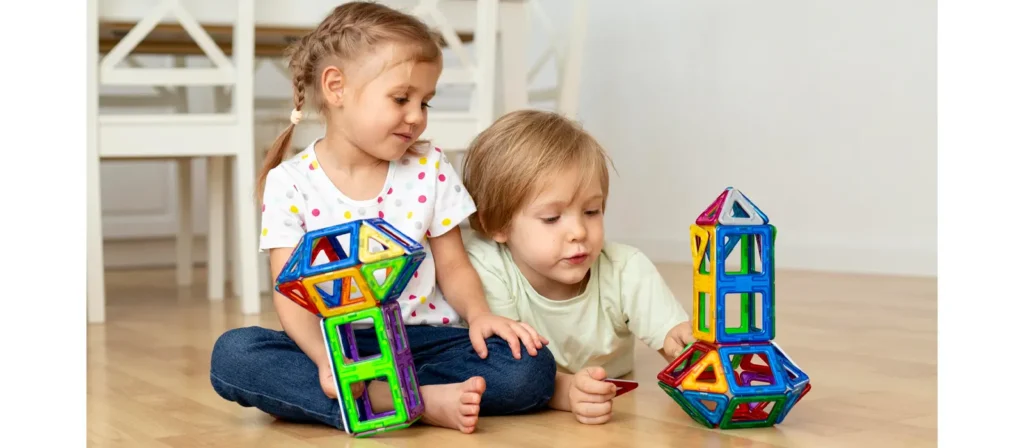
4. Parallel activities with social connection
Children may still engage in similar but separate activities, such as building individual block towers or drawing their own pictures. The difference from parallel play is that they now acknowledge and incorporate each other’s presence and actions into their play.
5. Emerging social skills and friendships
Through repeated interactions, children begin to understand social dynamics such as turn-taking, sharing attention, and respecting others’ ideas. These early social skills are essential for forming friendships and preparing for cooperative play.
6. Flexible and spontaneous play structure
Associative play is often fluid and unstructured. Children move in and out of activities, shift roles, and change ideas frequently, which supports creativity and adaptability.
Ready to design a space that inspires learning? Connect with us to create customized furniture solutions tailored to your classroom needs.
Examples of Associative Play
Associative play can take many forms in a preschool or home environment. These examples help illustrate how children begin to engage with one another while still maintaining individual goals. The focus is not on cooperation to achieve a shared outcome, but on interaction, communication, and social observation. Below are several typical situations that represent associative play in action.
- Block Building Near Peers
Two or more children sit next to each other, each building their own tower or structure with blocks. As they build, they talk about the colors, shapes, or how tall their towers are. They may occasionally hand a block to a peer or make suggestions, but each child focuses on their own creation. - Pretend Cooking in the Play Kitchen
Children play side by side in a pretend kitchen, each pretending to cook different meals. They talk about their recipes, offer pretend food to each other, and laugh at their imaginary menus. They are not working together on one meal, but they interact constantly through role play. - Drawing or Painting at the Same Table
Several children are seated at a table with paper and art supplies. Each child draws their own picture, but they comment on what their friends are drawing, ask to borrow crayons, or show off their artwork. The social exchange enhances creativity and language skills. - Playing with Dolls or Stuffed Animals
Children gather in a reading nook or play area, each with their own doll or stuffed animal. They talk about the names, clothes, or stories of their toys, occasionally acting out small scenes. While the play is not coordinated, the interaction adds a layer of shared experience. - Sand and Water Table Exploration
At a water table, children scoop, pour, and stir using different tools. They may use their own cups and containers, but they talk about what they are doing, watch others’ techniques, and try out new actions inspired by their peers. The activity remains individual, but the social presence is constant.
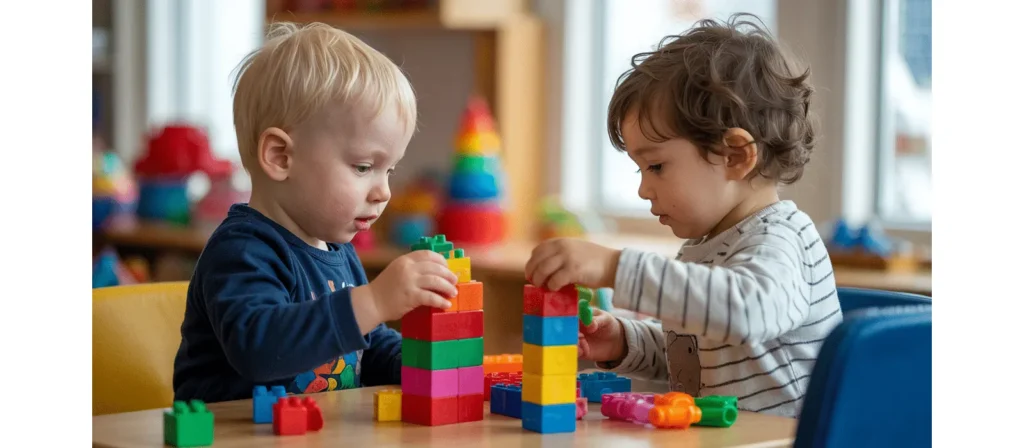
Distinguishing Associative Play from Parallel and Cooperative Play
Understanding associative play becomes clearer when we compare it to the stages that come before and after it in a child’s social development: parallel play and cooperative play. These three forms of play are all essential milestones, each building on the skills developed in the previous stage and preparing children for the next. Associative play acts as a bridge between independent exploration and fully collaborative activities.
Associative Play Vs Parallel Play
| Feature | Associative Play | Parallel Play |
|---|---|---|
| Interaction | Active social interaction through conversation, sharing, and imitation. | Minimal or no interaction, even though children are near each other. |
| Focus | Children are aware of and influenced by peers’ actions. | Children focus primarily on their own activity without engaging with others. |
| Use of Materials | Shared materials and exchange of resources. | Individual use of materials without sharing. |
| Communication | Frequent verbal and non-verbal communication. | Little to no communication beyond occasional observation. |
| Examples | Two children talk about what they are drawing and share crayons. | Two children draw separately, sitting side by side, without talking. |
| Developmental Significance | Prepares children for cooperation and teamwork. | Builds comfort with social proximity and parallel participation. |
Associative Play Vs Cooperative Play
| Feature | Associative Play | Cooperative Play |
|---|---|---|
| Goal of Play | No shared goal; children interact but pursue individual objectives. | Shared goal or project that all participants work toward together. |
| Organization | Loosely organized, spontaneous, and often unstructured. | Structured with planned roles, rules, or tasks. |
| Interaction Style | Conversations, sharing materials, and exchanging ideas without coordinated planning. | Collaborative planning, problem-solving, and collective decision-making. |
| Social Skills Practiced | Sharing, communication, empathy, and listening. | Teamwork, negotiation, leadership, compromise, and responsibility. |
| Examples | Children talk while building separate towers with blocks. | Children plan and build a single structure together, deciding who does each part. |
| Developmental Role | Serves as a bridge from individual play to group collaboration. | Represents the peak of social play, preparing children for group work and classroom cooperation. |
Ready to design a space that inspires learning? Connect with us to create customized furniture solutions tailored to your classroom needs.
Key Benefits of Associative Play
Associative play is much more than a simple stage of interaction. It is a crucial part of early childhood development that helps children build social awareness, emotional understanding, language ability, and cognitive flexibility. Through shared activities and conversations, children gain the foundational skills they need for learning and relationships in later life.
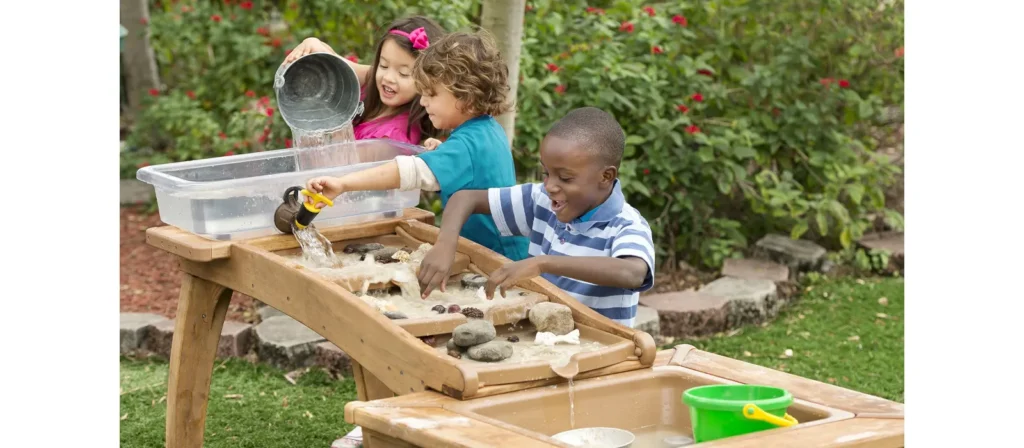
1. Strengthens Social and Communication Skills
Associative play offers children frequent opportunities to practice important social skills such as sharing, turn-taking, listening, and responding to others. These repeated interactions help them use language with purpose and confidence. As they discuss their ideas, ask questions, and exchange thoughts, their vocabulary grows and their ability to express themselves becomes stronger.
2. Encourages Cooperation and Teamwork
Although associative play does not require a shared goal, it prepares children to work with others. They learn to respect different ideas, adjust their actions based on peer feedback, and accept that others may think or behave differently. This flexible style of interaction makes future collaborative tasks easier and more natural.
3. Fosters Emotional Development and Empathy
Children experience a wide range of emotions during associative play. They notice how others feel, learn to express their own feelings, and begin to empathize with peers. This process builds emotional intelligence, helping them manage social situations with sensitivity and understanding.
4. Boosts Cognitive Growth and Problem-Solving
The dynamic conversations and shared decision-making that happen during associative play support critical thinking. Children learn to connect ideas, solve small conflicts, and adjust their approaches when faced with challenges. These skills contribute to cognitive flexibility and prepare them for more complex problem-solving experiences later.
5. Promotes Confidence and Independence
Associative play allows children to explore their own ideas while interacting with others in a safe environment. When their contributions are valued, they gain confidence in their abilities. This growing sense of self-assurance encourages them to participate more actively in group situations and express their thoughts openly.
6. Supports Readiness for Structured Learning
The abilities developed through associative play, including communication, cooperation, emotional regulation, and adaptable thinking, translate directly into classroom success. Children who have engaged in rich associative play often show greater readiness for group projects, collaborative learning, and structured classroom activities.
How to Encourage Associative Play?
Helping children develop associative play skills is one of the most valuable things educators and parents can do during the preschool years. While this stage often emerges naturally as children become more socially aware, the right environment, strategies, and support can significantly enrich the experience.
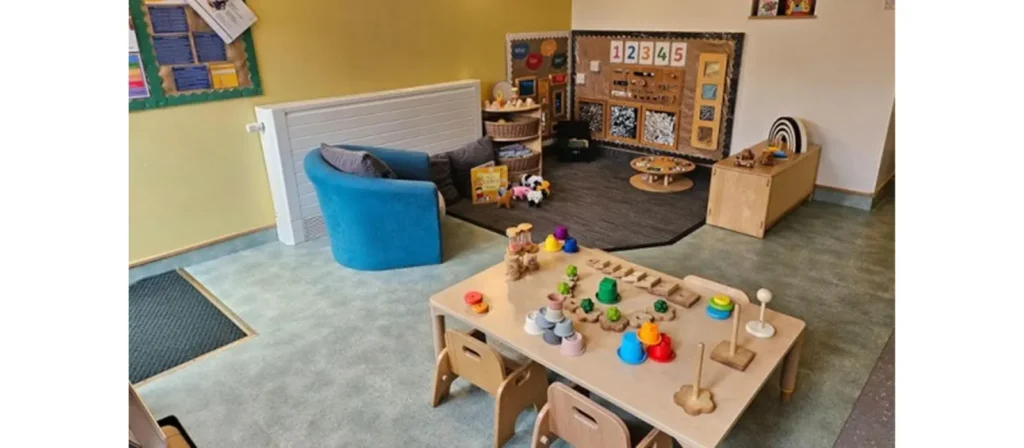
1. Create Open and Flexible Play Spaces
A welcoming and well-organized environment encourages children to interact naturally. Arrange furniture, toys, and activity areas in ways that allow children to see and approach one another easily. Open spaces without rigid structures make it easier for them to move between activities, share resources, and join each other’s play spontaneously.
2. Offer Materials That Invite Sharing and Interaction
Provide toys and resources that are naturally suited to group use. These materials encourage conversation, cooperation, and idea sharing. Children are more likely to talk, imitate, and exchange objects when the resources lend themselves to collaborative use.
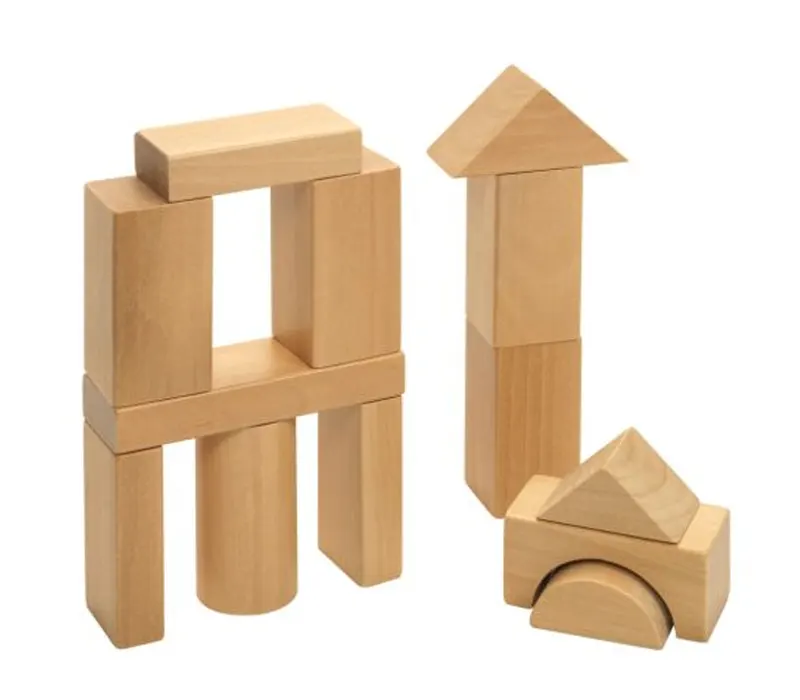
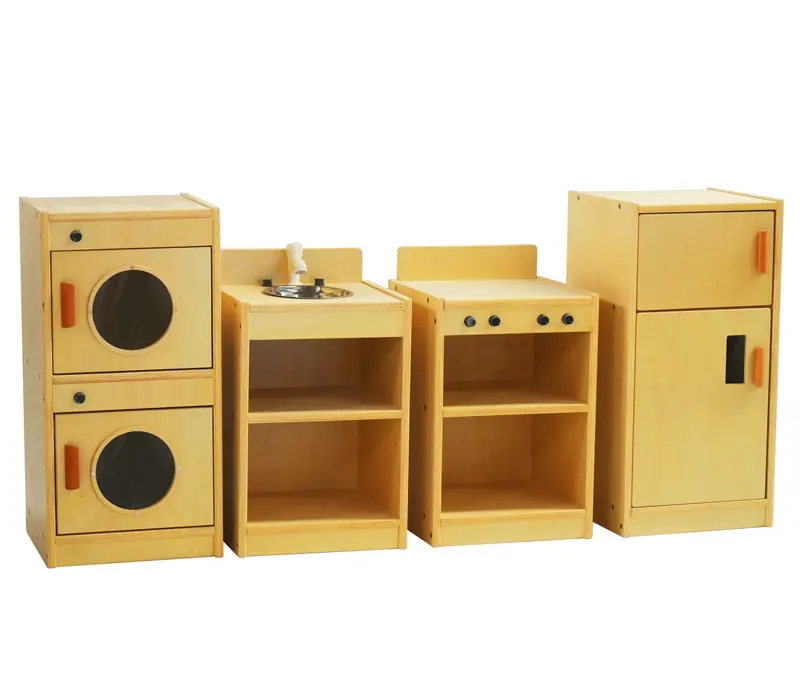

Engaging Toys to Support Associative Play:
- Pretend Play Sets
Toys such as kitchen sets, doctor kits, or mini grocery stores inspire rich conversation and role-playing. Children can act out real-life roles, comment on each other’s actions, and share accessories during play. - Building Blocks and Construction Toys
Items like wooden blocks, magnetic tiles, and interlocking bricks encourage parallel creation with social exchange. Children may build their own structures while discussing colors, shapes, or techniques with others nearby. - Art and Craft Supplies
Materials such as crayons, markers, playdough, and collage items invite children to sit together and express their creativity. While each child creates their own piece, conversation and shared materials naturally promote interaction. - Water and Sand Play Tools
Buckets, scoops, funnels, and toy animals used in a sensory table setting create ideal conditions for observational learning and imitation. Children often comment on what their peers are doing or try similar actions with different tools.
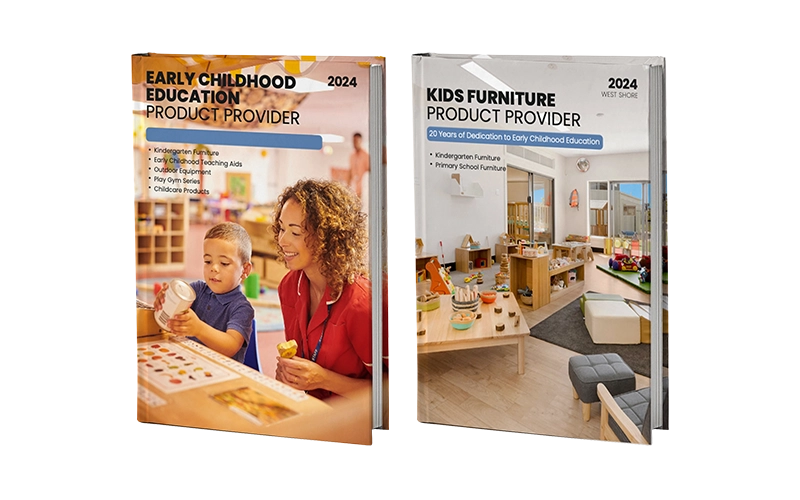
3. Model Social Behaviors and Communication
Adults play an important role in showing children how to interact. Use simple conversations, ask open-ended questions, and demonstrate turn-taking and polite exchanges during play. When children observe these behaviors, they are more likely to imitate them and integrate them into their interactions with peers.
4. Gently Facilitate, But Do Not Control
Guidance is helpful, but direct interference can limit creativity and natural social development. Instead of assigning roles or setting strict goals, offer subtle prompts that encourage collaboration. For example, you might suggest, “Maybe you could build together,” or “What could you add to your friend’s idea?” to spark cooperative behavior while allowing children to lead.
5. Encourage Small Group Activities
Small group play is an effective way to nurture associative play, especially for children who are still developing confidence in social settings. Activities like group art projects, shared storytelling, or building something side by side give children frequent chances to communicate and collaborate without the pressure of a large group dynamic.
6. Provide Time for Unstructured Play
Children need sufficient time to develop social connections and build shared experiences. Avoid over-scheduling or structuring every activity. Long periods of free play encourage natural transitions from solitary and parallel play into associative play as children have the time and space to explore interactions on their own terms.
7. Support Positive Social Problem-Solving
Disagreements are a natural part of associative play and offer valuable learning moments. Instead of solving conflicts for children, guide them in finding their own solutions by modeling respectful communication and encouraging empathy. This helps them build resilience, negotiation skills, and emotional intelligence.
FAQs
- Can associative play and parallel play happen at the same time?
Yes. It is common for children to move between different types of play during a single play session. A child might start in parallel play and shift into associative play as they become more comfortable and curious about their peers. - Is associative play appropriate for children with autism or developmental delays?
Yes. With the right support and environment, many children with developmental differences can benefit from associative play. ABA-based strategies, peer modeling, and guided play can help these children participate and build foundational social skills at their own pace. - What is Associative Play in ABA?
Behavior analysts view associative play as a context where multiple social behaviors emerge at once, including manding (requesting), tacting (labeling), turn-taking, and responding to peer initiations. These are all valuable components in ABA-based programs and are often tracked as part of the child’s progress in social development. - How Long Does the Associative Play Stage Last?
Associative play typically lasts from around age three to five, though the duration can vary based on each child’s developmental progress and social environment. Some children may move into cooperative play more quickly, while others may remain in the associative stage longer as they build confidence and communication skills. This stage often overlaps with both parallel and cooperative play, depending on the child and the context.
Conclusion
Associative play represents a vital stage in early childhood development where children begin to connect with peers through conversation, observation, and shared materials. Educators and families who recognize the importance of associative play can better support children’s growth by offering time, space, and tools that promote interaction without pressure.
At Westshore, we specialize in creating early learning environments that inspire connection. From child-centered furniture layouts to carefully selected toys that promote peer engagement, our solutions are designed to help children grow socially, emotionally, and cognitively through play.

